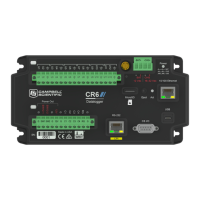6. Measurements
6.1 Voltage measurements 64
6.2 Current-loop measurements 66
6.3 Resistance measurements 69
6.4 Period-averaging measurements 77
6.5 Pulse measurements 78
6.6 Vibrating wire measurements 85
6.7 Sequential and pipeline processing modes 88
6.1 Voltage measurements
Voltage measurements are made using an Analog-to-Digital Converter (ADC). A high-
impedance Programmable-Gain Amplifier (PGA)amplifies the signal. Internal multiplexers route
individual terminals within the amplifier. The CRBasic measurement instruction controls the ADC
gain and configuration – either single-ended or differential input. Information on the differences
between single-ended and differential measurements can be found here: Deciding between
single-ended or differential measurements (p. 147).
A voltage measurement proceeds as follows:
1. Set PGAgain for the voltage range selected with the CRBasic measurement instruction
parameter Range. Set the ADC for the first notch frequency selected with fN1.
2. If used, turn on excitation to the level selected with ExmV.
3. Multiplex selected terminals (SEChan or DiffChan).
4. Delay for the entered settling time (SettlingTime).
5. Perform the analog-to-digital conversion.
6. Repeat for input reversal as determined by parameters RevEx and RevDiff.
7. Apply multiplier (Mult) and offset (Offset) to measured result.
Conceptually, analog voltage sensors output two signals: high and low. For example, a sensor
that outputs 1000 mV on the high signal and 0 mV on the low has an overall output of 1000 mV.
A sensor that outputs 2000 mV on the high signal and 1000 mV on the low also has an overall
output of 1000 mV. Sometimes, the low signal is simply sensor ground (0 mV). A single-ended
6. Measurements 64

